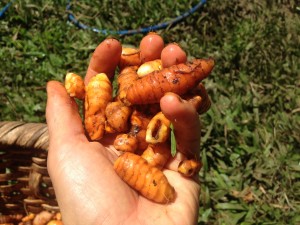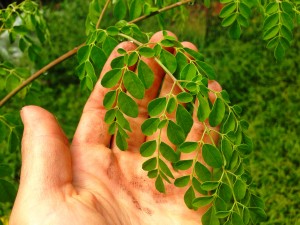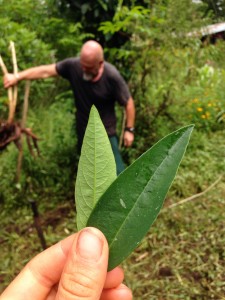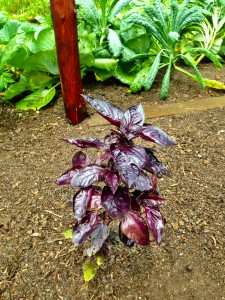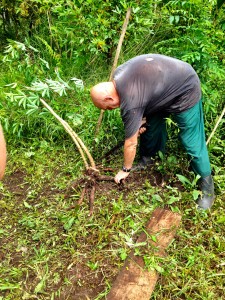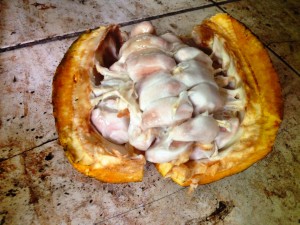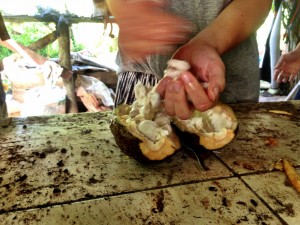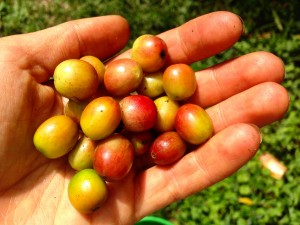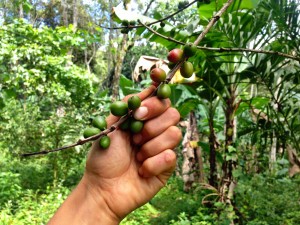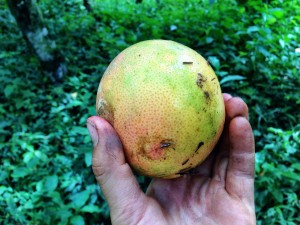The most entertaining experiences for me in Costa Rica have involved learning about how to gather (and eat) the abundance and variety of fruits and vegetables available almost all year-round here. There is an amazing assortment of species to be found both cultivated by people and simply growing wild—edible plants living along the country’s rivers and streams, among the jungle trees, rimming the beaches, and growing within the surrounding farms. I have never lived in a place with such a fantastic number of vegetables and fruit trees—some planted by human hand, others growing completely wild—a bounty sufficient to sustain the conscious and respectful human passerby.
Without a doubt, the variety and quantity of Costa Rica’s natural (food) resources have resulted in me becoming what can only be described as an avid gatherer.
At the farm where I work at, I can lose count of the edible life forms available for munching. To provide cooking spices and seasoning, we harvest ginger and turmeric. Using shovels and spades, we rush out to dig up the plants in the early morning before the tropical sun becomes intense and unforgiving.
The small tubers of both species are often buried surprisingly deep, and you have to take care not to unwittingly spear or slice them with your tool. We remove and separate the tubers by hand, and place our bounty out on racks to dry (or dice everything fresh).
Note: I’m beginning to think my fingers and clothes and toothbrush may forever be tinted yellow from the turmeric, but its nutritional powers and wild taste are still far too alluring for now…
We also have access to pepper. Initially just small green balls when pulled off the stem, the little pods quickly turn black when left out to dry—transformed by the sun into the hard black pepper that we are so accustomed to rummaging around for in our spice drawers.
Beyond spices and seasonings, we enjoy the healthy fats and protein of various seeds, including sesame, chia, and red amaranth. For all three of these, the harvesting process is essentially the same: we pluck the stem containing the seed pods and/or flower, and allow the whole thing to dry out on racks before gently shaking out the seeds into a bowl or other container.
To build a farm salad, the options are seemingly endless: planted kale, arugula, purple basil, cabbage, and mustard, together with wild moringa (the “miracle tree”), katuk (rich in protein), hibiscus (sweet in flavor), and red amaranth leaves (just to name a few). I always eat a guayaba tree leaf as well—just one a day—chewing it slowly for maximum absorption of its antioxidants.
Added to my bowl—by now a giant leafy assortment of veggies—I like to incorporate carrots and radishes. Uprooting these vegetables often produces peals of laughter, as they tend to grow downwards in an entirely haphazard way—twisted into the kinds of hilarious, stunted forms rarely seen (or entirely absent from) supermarket shelves.
For the main course, you can easily create curries from boiled yucca and chayote (a kind of squash that has the consistency of a pear once boiled).
Yucca is particularly entertaining to harvest, as it involves pulling up an entire tree! The tubers are in fact the tree’s roots, but the spindly trunk can easily be replanted (and thrive)—even providing a second harvest several months later following its first uprooting.
Bananas and fried plantains add an incredible final touch to the meal. Bananas (and I believe plantains as well) propagate in a pretty bizarre fashion. As the bananas grow out from the banana flower (pictured below), the bunch eventually becomes too heavy for the tree to support. The situation becomes so dire, that if the bunch is not harvested by human hand (and allowed to ripen on the ground), the weight of the bunch can (and usually does) topple the entire tree. This “flopping over” of sorts can be blamed on the banana tree’s rather small, pathetically shallow roots. Luckily, the banana is somewhat of a walking plant, and simply sprouts a second trunk (a new tree!) that peels directly out from the trunk of the first.
Besides eating the bananas raw (which is amazing in and of itself here, as they taste incredibly sweet), you can also dry them. By removing the peel and sprinkling the fruit with turmeric to ward off bacteria, you can leave your (soon to be) banana snacks out in slats in a drying room until they are miniature in size and chewy.
Voilà! Within a few days you have created easily transportable fuel for long hikes or work on the farm.
Of course, if you need a serious energy boost, it is best to go munch a handful of coffee or cacao beans (well really I would recommend just sticking with the cacao beans…the coffee tastes terrible).
The process of harvesting cacao involves a trek into the woods with a backpack or some other handy gathering apparatus. We search the trees for ripened yellow pods (if they are green, they are not yet ripe, if they are black, they have already been incubated with bacteria used by ants to harvest the pods’ sugar, or have succumbed to the rain and begun to mold). Bringing whatever treasured fruit we manage to find and harvest back to the farm, you then crack open the pods with a machete (a task I avoid for everyone’s safety) and remove the seeds.
When the pod is first opened, the seeds are covered in the pod’s white slimy fruit (which can be eaten, although the texture horrifies me). After scraping off as much slime as possible, we place the beans into a bucket to ferment, and then dry them on slats. Once the beans are dry, the final step is to remove the skin (wherein they can be eaten raw, or ground and tempered into chocolate).
The harvest and processing of coffee beans is similar in some ways, but it requires far less diligence. Bright, red beans in their natural state, our little bundles of coffee ripen haphazardly among the various plants found sprinkled around the farm. The ultimate flavor of the beans depends on a number of factors: the tree’s elevation, soil type, the degree of sun or shade, and the surrounding vegetation. Many people have described the coffee made from the beans produced by particular stands as taking on the taste of chocolate or various fruits.
We collect the red (ripe) beans (or yellow in some varieties) in buckets, dry them, and remove the skins (by hand, or more efficiently, by machine). The beans are then ready to be roasted. Note: The length of time for which you decide to roast the beans for generally depends on your affinity for the taste of bitterness in your morning cup.
And last but not least…the fruits. I eagerly gather familiar blackberries, although they have a distinctly sour flavor here. You do, of course, have to beware of the wasps and ants that also flock to these lush purple bulbs.
Mangos here are sadly nearly out of season now (as are the papayas), but there is no time to mourn, as the mangosteen trees have begun producing their bizarre (albeit heavenly) lychee-like fruit.
Beyond that are various varieties of oranges and mandarins. Some of the varieties of these fruits are sour, while and others sweet. A few even have skins that you can eat (graced by a chewable covering high in vitamin A).
My favorites fruit may be the grapefruit: hilariously huge globes hanging and falling with a great raucous from the trees. We have both white and pink varieties on the farm (although the pink is esteemed–it’s much sweeter).
From there, you can move on to lemons and limes—wonderful additions to our avocado tree, as they allow for seemingly endless bowls of guacamole.
While there are many aspects of the tropics that I openly despise—the extreme heat, the relentless biting insects, the poisonous spiders hiding in your shoes and catching a ride on your clothes if you’re not careful….the food here seems unparalleled, and the experience of harvesting, preparing, and eating it endlessly entertaining.
What would the world look like if all grew more of our own food? If we taught our children the magic of a fruit tree or a chayote vine…would it foster a greater appreciation for this world? For our beautiful green planet?
I am thankful for the abundance found within this little world of mine—for the peace found in the trees and gardens here. In a world that can feel hopeless in its violence, it’s the little things— the almost magical aspects of life that offer a different vision for the planet. We have only to look around.



